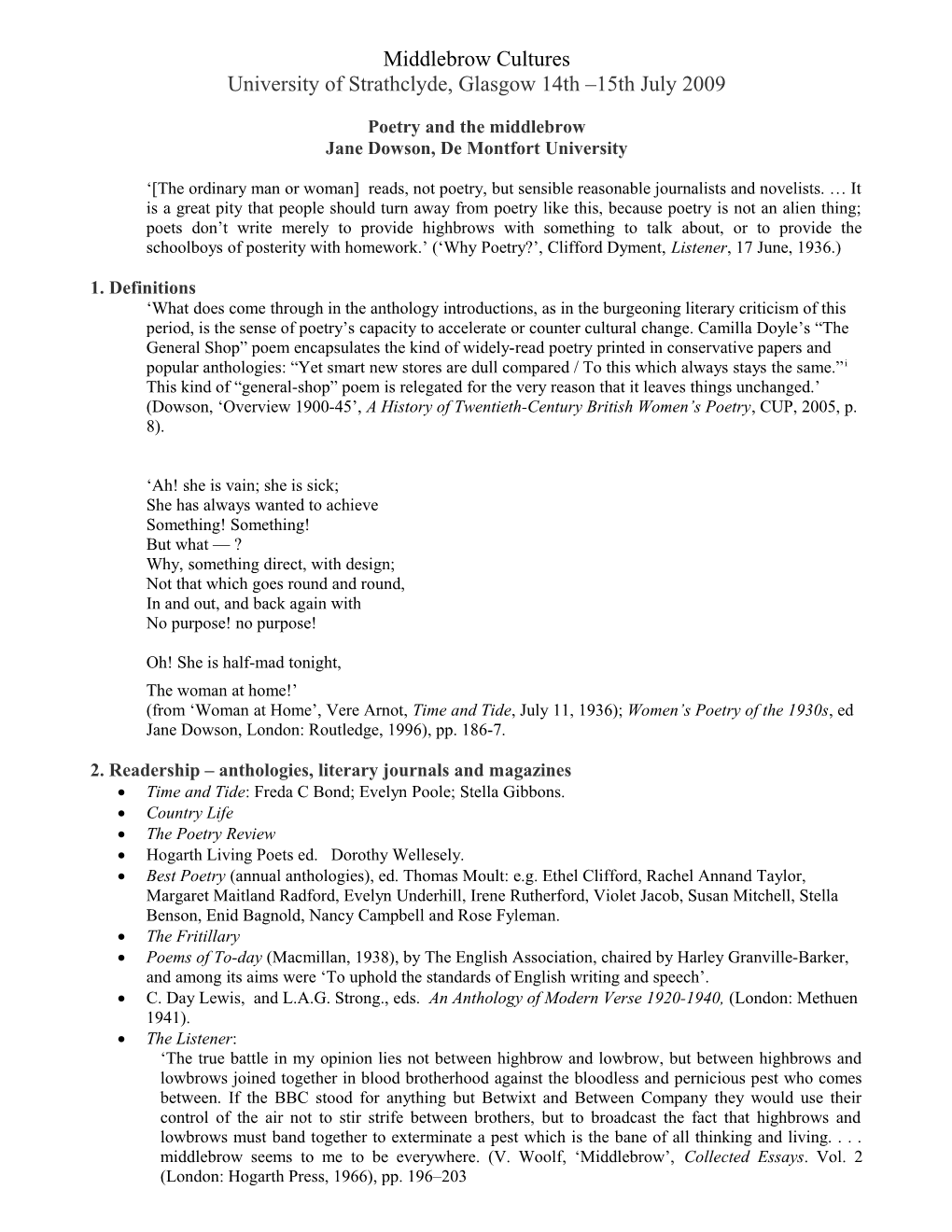Middlebrow Cultures
University of Strathclyde, Glasgow 14th –15th July 2009
Poetry and the middlebrow
Jane Dowson, De Montfort University
‘[The ordinary man or woman] reads, not poetry, but sensible reasonable journalists and novelists. … It is a great pity that people should turn away from poetry like this, because poetry is not an alien thing; poets don’t write merely to provide highbrows with something to talk about, or to provide the schoolboys of posterity with homework.’ (‘Why Poetry?’, Clifford Dyment, Listener, 17 June, 1936.)
1. Definitions
‘What does come through in the anthology introductions, as in the burgeoning literary criticism of this period, is the sense of poetry’s capacity to accelerate or counter cultural change. Camilla Doyle’s “The General Shop” poem encapsulates the kind of widely-read poetry printed in conservative papers and popular anthologies: “Yet smart new stores are dull compared / To this which always stays the same.”[i] This kind of “general-shop” poem is relegated for the very reason that it leaves things unchanged.’ (Dowson, ‘Overview 1900-45’, A History of Twentieth-Century British Women’s Poetry, CUP, 2005, p. 8).
‘Ah! she is vain; she is sick;
She has always wanted to achieve
Something! Something!
But what — ?
Why, something direct, with design;
Not that which goes round and round,
In and out, and back again with
No purpose! no purpose!
Oh! She is half-mad tonight,
The woman at home!’
(from ‘Woman at Home’, Vere Arnot, Time and Tide, July 11, 1936); Women’s Poetry of the 1930s, ed Jane Dowson, London: Routledge, 1996), pp. 186-7.
2. Readership – anthologies, literary journals and magazines
- Time and Tide: Freda C Bond; Evelyn Poole; Stella Gibbons.
- Country Life
- The Poetry Review
- Hogarth Living Poets ed. Dorothy Wellesely.
- Best Poetry (annual anthologies), ed. Thomas Moult: e.g. Ethel Clifford, Rachel Annand Taylor, Margaret Maitland Radford, Evelyn Underhill, Irene Rutherford, Violet Jacob, Susan Mitchell, Stella Benson, Enid Bagnold, Nancy Campbell and Rose Fyleman.
- The Fritillary
- Poems of To-day (Macmillan, 1938), by The English Association, chaired by Harley Granville-Barker, and among its aims were ‘To uphold the standards of English writing and speech’.
- C. Day Lewis, and L.A.G. Strong., eds. An Anthology of Modern Verse 1920-1940, (London: Methuen 1941).
- The Listener:
‘The true battle in my opinion lies not between highbrow and lowbrow, but between highbrows and lowbrows joined together in blood brotherhood against the bloodless and pernicious pest who comes between. If the BBC stood for anything but Betwixt and Between Company they would use their control of the air not to stir strife between brothers, but to broadcast the fact that highbrows and lowbrows must band together to exterminate a pest which is the bane of all thinking and living. . . . middlebrow seems to me to be everywhere. (V. Woolf, ‘Middlebrow’, Collected Essays. Vol. 2 (London: Hogarth Press, 1966), pp. 196–203
‘The poets are alive, but their public is dead.’ (Herbert Read, ‘‘An Open Letter—To the new Director of the BBC’ (Ogilvie), New Verse, nos. 31—2, Autumn 1938, p. 10.)
‘The worst kind of conservatism is that which will not adventure: it will ride in the modern Tube, but will not venture from the poetry of Walter de la Mare, merely because that poetry seems unfamiliar; it will stand enchanted before a Rolls Royce, but see nothing remarkable in W.B. Yeats. And thus it results that only the mechanical is marvellous.
Perhaps these dull conventionalists are bewildered, but in truth the only bewildering thing in modern poetry is its variety, and in modern poets their number’. (‘A Survey of Modern Poetry’, John Freeman, 6 Feb, 1929.)
- 1933 Poetry competition.
- 1938 series ‘The Poet and the Public’.
- Dominant poets include: Margaret Stanley-Wrench; Winifred Welles; Jan Struther; Clifford Dyment; Richard Church. Poems of Tomorrow, ed. Janet Adams Smith, 1935.
Further reference:
Dowson, ‘Poetry and The Listener: the Myth of the “ Middlebrow”,
Fred Hunter, ‘Hilda Matheson and the BBC: 1926-40’, This working day world: Women’s Lives and Culture(s) in Britain 1914-45, ed. Sybil Oldfield. (Taylor and Francis, 1994.)
3. Critical Reception
- Times Literary Supplement
- New Statesman
- Prizewinners e.g. The Queen’s Medal; Newdigate; Hawthornden.
Miss Snooks was really awfully nice
And never wrote a poem
That was not really awfully nice
And fitted to a woman,
She therefore made no enemies
And gave no sad surprises
But went on being awfully nice
And took a lot of prizes.
(Stevie Smith, ‘Miss Snooks, Poetess’, Printed in Poetry (November 1964). Me Again: The Uncollected Writings of Stevie Smith, eds. Barbara, Jack and William McBrien(London: Virago, 1988), p. 226.
4. Projects
- Georgians: e.g. Fredegonde Shove; Margaret L Woods; Frances Cornford; Vita Sackville West; Winifred Letts.
- War Poetry – Letts; Vera Brittain; Margaret Sackville; May Wedderburn Caannon; Helen Parry Eden. See Catherine Reilly, ed The Virago Book of War Poetry by Women (1997).
- Due for investigation: Muriel Stuart; Helen Hamilton; Teresa Hooley; Eleanor Farjeon; Rose Macaulay; ‘Susan Miles’ (Ursula Roberts).
5. Resources
The Poetry Library, South Bank London.
British Library.
Peter Brooker and Andrew Thacker, eds. The Oxford Critical and Cultural History of Modernist Magazines: Britain and Ireland 1880-1955 v. 1 (Oxford University Press, 2009).
Alvin Sullivan, ed. British Literary Magazines: The Modern Age, 1914-84 (Connecticut: Greenwood Press, 1986).
[i] Camilla Doyle, The General Shop and Other Poems (London: St Catherine’s Press, 1937).
